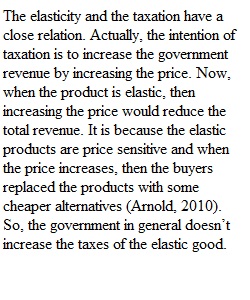


Q You just won a contest and have been appointed City of New York Tax Commissioner (you might be asking, why did I enter such a contest? :)). Your primary goal is two-fold: raise revenue and make the tax code more efficient. Since we are in the chapter on elasticity, you are aware that increasing prices (which increasing taxes do) can both increase and decrease revenue, and that lowering prices/taxes can both increase and decrease revenue. You have to decide which goods to tax, which goods to raise taxes on and which good to lower taxes. Choose one of the following potential revenue sources and -- focusing on elasticity, supply and demand -- logically justify increasing the tax rate. 1. Alcohol, tobacco and gasoline are already heavily taxed. Should you raise these taxes? Select one and explain your answer. 2. Medical services, electricity and fruits and vegetables are not taxed. Should you start to tax these? Select one and explain your answer. Good Luck to you Mr. or Madame Commissioner.
View Related Questions